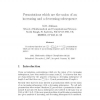72 search results - page 1 / 15 » Increasing Subsequences and the Classical Groups |
COMBINATORICS
1998
13 years 4 months ago
1998
We show that the moments of the trace of a random unitary matrix have combinatorial interpretations in terms of longest increasing subsequences of permutations. To be precise, we s...
COMBINATORICS
1998
13 years 4 months ago
1998
It is shown that there are 2n n − n−1 m=0 2n−m−1 2m m permutations which are the union of an increasing sequence and a decreasing sequence. 1991 Mathematics Subject Classi...
DIS
2009
Springer
13 years 11 months ago
2009
Springer
Abstract. Group comparison per se is a fundamental task in many scientific endeavours but is also the basis of any classifier. Contrast sets and emerging patterns contrast betwee...
CSCW
2010
ACM
14 years 1 months ago
2010
ACM
A successful collaborative tool designed to aid discussion must be flexible, maintain the user’s coordinative agency, and be appropriable in many contexts. We have developed a ...
COMBINATORICS
2004
13 years 4 months ago
2004
This paper finds and analyzes a formula for the total variation distance between iterations of riffle shuffles and iterations of "cut and then riffle shuffle". This allo...

